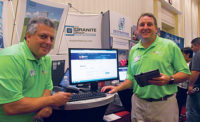Colorful booths, the smell of fresh popcorn, shoulder-to-shoulder traffic, vendors hawking their wares - these are all typical of industry trade shows across the country. According to a study published in the book "Guerrilla Trade Show Selling," 91% of the 1,009 decision makers surveyed identified trade shows as useful for making critical purchasing decisions.
Trade shows are unique for the variety of pressures they create: shortened and compressed time frame for the selling process; high expectations by both exhibitors and attendees; the need to be "on-stage" and energized constantly; and switching roles from exhibitor to attendee. For these reasons, many salespeople approach trade shows with less than positive enthusiasm. Companies also contribute to these negative attitudes by failing to plan and adequately train their sales staffs. Yet trade shows can be fun, exciting and challenging by following these simple guidelines.
Inside-out - the exhibitor
Planning is the key word for any exhibitor. Deciding on what trade shows to attend should begin a year in advance. By properly researching prospective trade show demographics, the company can determine the number of exhibitors and attendees; past assessments of each show; competitors' booth sizes and locations; and location of high-traffic booths (outside aisles, corner locations, proximity to food court, etc.).Costs of the show can be assessed beforehand, including booth rental costs - power sources, tables, chairs, carpeting and skirting - and exhibitors' possible promotional costs based upon potential visitors ("freebies," literature, food, booth display, etc.).
Set measurable, realistic and attainable sales goals and communicate those goals to the sales staff. Establish benchmarks to determine a return on investment and a follow-up process to contact qualified prospects.
Preparation of the sales staff is vital. Given the unique environment of trade shows, choose individuals who can work in a fast-paced, high-energy environment and can close any possible sale. Remember that the highest-performing salesperson may not be the best individual for trade shows.
Sales staff preparation should include a review of demographics from exhibitors to competitors; an extensive knowledge of products or services being displayed and the ability to communicate same to the attendees; and a thorough understanding of trade-show behavior and how to maximize sales performance.
Personal appearance is also important. Nametags should be worn on the right side of a shirt or jacket to reinforce the salesperson's name when greeting new prospects. Select comfortable and professional clothing, and make sure to have plenty of professionally produced business cards and literature.
Specific goals for new prospects, appointments and orders must be determined before the show, as well as booth assignments and times if more than one salesperson is exhibiting. When you tour the show, decide on specific times and establish objectives, such as viewing new products or securing new industry information.
After the show, analyze it from an exhibitor's and an attendee's perspective. Schedule the first available business day after the trade show to respond to promised calls, and mail specific literature and acknowledgement notes to those attendees who demonstrated some interest in your booth.
Outside-in - the attendee
Trade shows offer attendees almost unlimited networking opportunities. However, attendees also need to properly plan for the trade show.A review of past demographics and the layout of the trade show are critical for success. A map highlighting the must-see booths is a simple solution.
Attendees also need to set specific, measurable and attainable goals that include the number of prospects, number of secured appointments and, if applicable, number of orders. These goals will keep attendees from spending too much time with previous friends and acquaintances.
Attendees also need a process for follow-up, which may begin during the trade show. Keep received business cards in your left pocket and your own business cards in your right pocket. During a quiet time, sit down and make any notes on the back of the received business cards as well as on the handouts.
This is also an excellent time to review your goals to ensure achievement by the close of the trade show. Upon returning to the office, immediately respond to any promised calls or mailings.
Finally, attendees have the opportunity to observe and evaluate the overall atmosphere of the trade show. They can determine what booths were successful and why, which freebies went well and which didn't, what improvements could be made for future trade shows and why this trade show should be attended next year.
Whether you are an Inside-Out or Outside-In participant in a trade show, the most important factor for success is your attitude, because attitudes drive behaviors and behaviors drive results.

